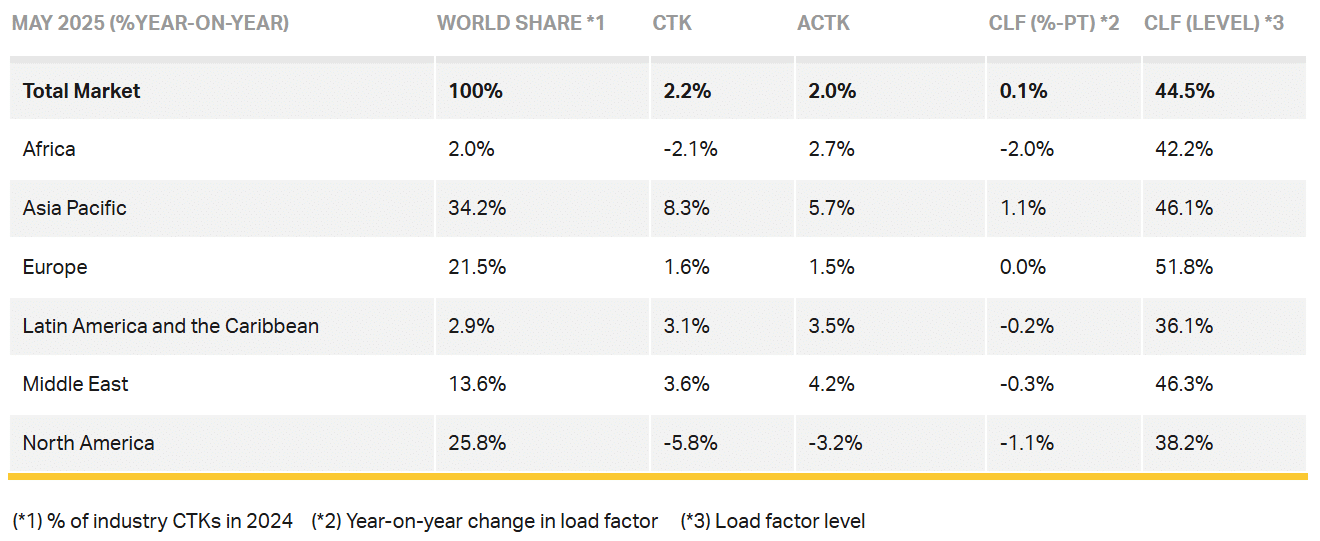07 de julho de 2025
Air cargo traffic up 2% in May despite trade uncertainties
Air cargo traffic grew overall in May, despite contractions on certain trade lanes attributed to U.S. trade policies, according to data released June 31 by IATA.
May’s air cargo traffic, measured in cargo tonne kilometers (CTK), rose 2.2% year over year and traffic on international lanes grew 3% YoY.
Capacity, measured in available CTKs, rose 2% YoY and rose 2.6% YoY for international operations.
The traffic increase “is encouraging news as a 10.7% drop in traffic on the Asia-to-North America trade lane illustrated the dampening effect of shifting U.S. trade policies,” IATA Director General Willie Walsh said in the release.
“Even as these policies evolve, already we can see the air cargo sector’s well-tested resilience helping shippers to accommodate supply chain needs to flexibly hold back, reroute or accelerate deliveries,” he said.

External factors
The release highlighted these operating environment factors:
- Global industrial production rose 2.6% YoY in April and global trade grew 3.8% YoY in March, the latest data available. Air cargo traffic in April grew 5.8% YoY.
- Jet fuel prices in May dropped 18.8% YoY and 4.3% month over month, IATA reported. Jet fuel spot prices in the U.S. in May fell YoY for the eleventh consecutive month.
- May’s Purchasing Managers’ Index (PMI) for global manufacturing output fell to 49.1. A PMI above 50 indicates growth and one below 50 indicates contraction. The PMI for new export orders was 48, “reflecting pressure from recent U.S. trade policy changes,” IATA said.
 (Courtesy/IATA)
(Courtesy/IATA)
Regional performance
Asia-Pacific carriers saw the most YoY traffic growth of all regions, while North America saw the largest YoY decline. By region YoY:
- Asia-Pacific carrier traffic grew 8.3% and capacity grew 5.7%;
- Middle Eastern carrier traffic grew 3.6% and capacity grew 4.2%.
- Latin American carrier traffic grew 3.1% and capacity grew 3.5%;
- European carrier traffic grew 1.6% and capacity grew 1.5%; and
- African carrier traffic fell 2.1% and capacity grew 2.7%;
- North American carrier traffic fell 5.8% and capacity fell 3.2%;
The Europe-Asia trade lane grew the most in May and accounted for 20.5% of the market share. The largest trade lane by market share at 24.4%, Asia-North America contracted 10.7% YoY. By trade lane:
- Europe-Asia grew 13.4% YoY, the 27th consecutive month of growth;
- Middle East-Asia grew 10.8% YoY, the third consecutive month of growth;
- Intra-Asia grew 9.1% YoY, the 19th consecutive month of growth;
- North America-Europe grew 8.2% YoY, the 16th consecutive month of growth;
- Middle East-Europe fell 0.9% YoY, the fifth consecutive month of contraction;
- Asia-North America fell 10.7% YoY, ending two months of consecutive growth; and
- Africa-Asia fell 14.6% YoY, the sixth consecutive month of contraction.
Analysts attribute the significant drop on the Asia-North America trade lane to trade tensions between China and the United States. The gains on the trade lane in March and April were partially attributed to front-loading ahead of U.S. tariff changes.
